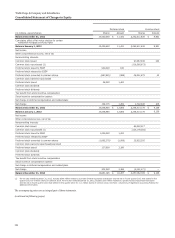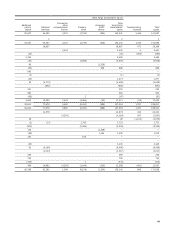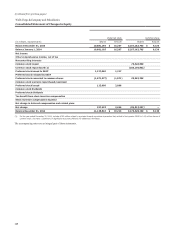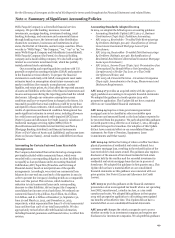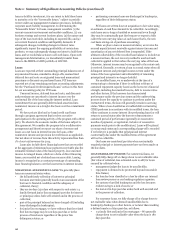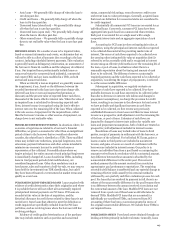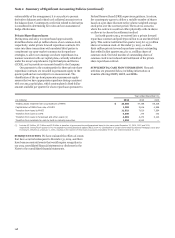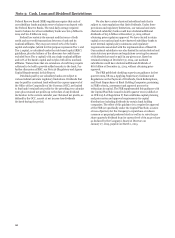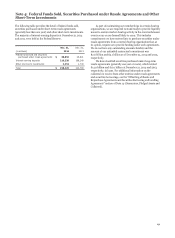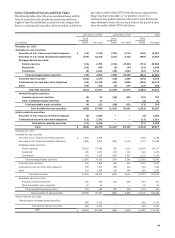Wells Fargo 2014 Annual Report Download - page 145
Download and view the complete annual report
Please find page 145 of the 2014 Wells Fargo annual report below. You can navigate through the pages in the report by either clicking on the pages listed below, or by using the keyword search tool below to find specific information within the annual report.• Auto loans – We generally fully charge off when the loan is
120 days past due.
• Credit card loans – We generally fully charge off when the
loan is 180 days past due.
• Unsecured loans (closed end) – We generally fully charge
off when the loan is 120 days past due.
• Unsecured loans (open end) – We generally fully charge off
when the loan is 180 days past due.
• Other secured loans – We generally fully or partially charge
down to net realizable value when the loan is 120 days past
due.
IMPAIRED LOANS We consider a loan to be impaired when,
based on current information and events, we determine that we
will not be able to collect all amounts due according to the loan
contract, including scheduled interest payments. This evaluation
is generally based on delinquency information, an assessment of
the borrower’s financial condition and the adequacy of collateral,
if any. Our impaired loans predominantly include loans on
nonaccrual status for commercial and industrial, commercial
real estate (CRE) and any loans modified in a TDR, on both
accrual and nonaccrual status.
When we identify a loan as impaired, we generally measure
the impairment, if any, based on the difference between the
recorded investment in the loan (net of previous charge-offs,
deferred loan fees or costs and unamortized premium or
discount) and the present value of expected future cash flows,
discounted at the loan’s effective interest rate. When the value of
an impaired loan is calculated by discounting expected cash
flows, interest income is recognized using the loan’s effective
interest rate over the remaining life of the loan. When collateral
is the sole source of repayment for the impaired loan, rather
than the borrower’s income or other sources of repayment, we
charge down to net realizable value.
TROUBLED DEBT RESTRUCTURINGS In situations where, for
economic or legal reasons related to a borrower’s financial
difficulties, we grant a concession for other than an insignificant
period of time to the borrower that we would not otherwise
consider, the related loan is classified as a TDR. These modified
terms may include rate reductions, principal forgiveness, term
extensions, payment forbearance and other actions intended to
minimize our economic loss and to avoid foreclosure or
repossession of the collateral. For modifications where we
forgive principal, the entire amount of such principal forgiveness
is immediately charged off. Loans classified as TDRs, including
loans in trial payment periods (trial modifications), are
considered impaired loans. Other than resolutions such as
foreclosures, sales and transfers to held-for-sale, we may remove
loans held for investment from TDR classification, but only if
they have been refinanced or restructured at market terms and
qualify as a new loan.
PURCHASED CREDIT-IMPAIRED LOANS Loans acquired with
evidence of credit deterioration since their origination and where
it is probable that we will not collect all contractually required
principal and interest payments are PCI loans. PCI loans are
recorded at fair value at the date of acquisition, and the
historical allowance for credit losses related to these loans is not
carried over. Some loans that otherwise meet the definition as
credit-impaired are specifically excluded from the PCI loan
portfolios, such as revolving loans where the borrower still has
revolving privileges.
Evidence of credit quality deterioration as of the purchase
date may include statistics such as past due and nonaccrual
status, commercial risk ratings, recent borrower credit scores
and recent loan-to-value percentages. Generally, acquired loans
that meet our definition for nonaccrual status are considered to
be credit-impaired.
Substantially all commercial PCI loans are accounted for as
individual loans. Conversely, consumer PCI loans have been
aggregated into pools based on common risk characteristics.
Each pool is accounted for as a single asset with a single
composite interest rate and an aggregate expectation of cash
flows.
Accounting for PCI loans involves estimating fair value, at
acquisition, using the principal and interest cash flows expected
to be collected discounted at the prevailing market rate of
interest. The excess of cash flows expected to be collected over
the carrying value (estimated fair value at acquisition date) is
referred to as the accretable yield and is recognized in interest
income using an effective yield method over the remaining life of
the loan, or pool of loans, in situations where there is a
reasonable expectation about the timing and amount of cash
flows to be collected. The difference between contractually
required payments and the cash flows expected to be collected at
acquisition, considering the impact of prepayments, is referred
to as the nonaccretable difference.
Subsequent to acquisition, we regularly evaluate our
estimates of cash flows expected to be collected. If we have
probable decreases in cash flows expected to be collected (other
than due to decreases in interest rate indices and changes in
prepayment assumptions), we charge the provision for credit
losses, resulting in an increase to the allowance for loan losses. If
we have probable and significant increases in cash flows
expected to be collected, we first reverse any previously
established allowance for loan losses and then increase interest
income as a prospective yield adjustment over the remaining life
of the loan, or pool of loans. Estimates of cash flows are
impacted by changes in interest rate indices for variable rate
loans and prepayment assumptions, both of which are treated as
prospective yield adjustments included in interest income.
Resolutions of loans may include sales of loans to third
parties, receipt of payments in settlement with the borrower, or
foreclosure of the collateral. For individual PCI loans, gains or
losses on sales to third parties are included in noninterest
income, and gains or losses as a result of a settlement with the
borrower are included in interest income. Our policy is to
remove an individual loan from a pool based on comparing the
amount received from its resolution with its contractual amount.
Any difference between these amounts is absorbed by the
nonaccretable difference for the entire pool. This removal
method assumes that the amount received from resolution
approximates pool performance expectations. The remaining
accretable yield balance is unaffected and any material change in
remaining effective yield caused by this removal method is
addressed by our quarterly cash flow evaluation process for each
pool. For loans that are resolved by payment in full, there is no
release of the nonaccretable difference for the pool because there
is no difference between the amount received at resolution and
the contractual amount of the loan. Modified PCI loans are not
removed from a pool even if those loans would otherwise be
deemed TDRs. Modified PCI loans that are accounted for
individually are considered TDRs, and removed from PCI
accounting if there has been a concession granted in excess of
the original nonaccretable difference. We include these TDRs in
our impaired loans.
FORECLOSED ASSETS Foreclosed assets obtained through our
lending activities primarily include real estate. Generally, loans
143



